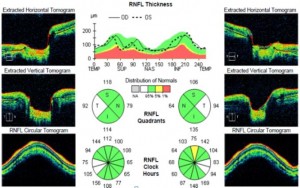Early detection in any disease is the only way to fight the glaucoma because damages done to the optic nerves are not reversible. Researches telling us that in progression of glaucoma, we may loose substantial amount of optic nerve cells even before det ected by conventional means like visual field test and fundus photography. Ganglion cells in retinas are like a canary in a coal mine. It get affected way before visual outcomes or funds photography chan
ected by conventional means like visual field test and fundus photography. Ganglion cells in retinas are like a canary in a coal mine. It get affected way before visual outcomes or funds photography chan
ges. The Holy grail of glaucoma diagnosis is detecting early changes on retinal ganglion cells. They are only measurably visible in High Definition Spectral Optical Coherent Tomography ( HD -OCT). Some OCT machines can even scan the anterior chamber angles and corneal tissues. Anterior chamber angle is directly responsible for high eye pressures in glaucoma.
We offer HD – OCT optic nerve scans and anterior chamber angle OCT scans to glaucoma patients and glaucoma suspects. Normal tension glaucoma ( glaucoma with Normal to Low eye pressure) is very difficult to early detect in conventional means without HD OCT scan. If you have family history of glaucoma, or were told about cupping of optic nerve or high pressure, HD- OCT can be definitive test to rule out the possibility of disease.
You can call us to request an appointment to just have OCT scan and consultation, or you can request for full glaucoma work up to rule out the disease.

 Glaucoma is an eye disease in which the pressure of the eyes increase, causing damage to the nerve fibers in the optic nerve which may lead to vision loss. The pressure increase happens when the passages that normally allow fluid in your eyes to drain become clogged or blocked.
Glaucoma is an eye disease in which the pressure of the eyes increase, causing damage to the nerve fibers in the optic nerve which may lead to vision loss. The pressure increase happens when the passages that normally allow fluid in your eyes to drain become clogged or blocked.